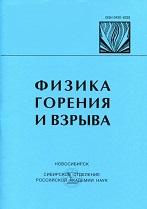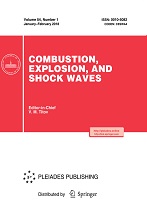|
Relaxation features of light emission from hot spots depending on the characteristics of the environment
S. A. Bordzilovskii, S. M. Karakhanov, A. V. Plastinin
Lavrentyev Institute of Hydrodynamics of Siberian Branch of the Russian Academy of Sciences, Novosibirsk, Russia
Abstract:
The light emission from samples representing a transparent matrix with inclusions of hot spots was studied. The matrix material was water and epoxy resin. Hot spots were generated by shock-wave compression of MS-B hollow glass microballoons. In the pressure range 0.7–29 GPa, the time of brightness decay was 280 to 70 ns. The brightness decay time increased by more than an order of magnitude when replacing the optical window made of solid epoxy resins by LiF. However, even this increase in the brightness decay time is much shorter than the estimates of the temperature relaxation of hot spots due to heat conduction mechanisms in the calculation with stationary parameters ($t_a$ = 10$^{-2}$ s) and due to light emission ($\tau$ = 2.4 $\cdot$ 10$^{-3}$ s). It is concluded that the dominant mechanism of temperature relaxation is the turbulent mixing of the medium behind the shock-wave front. The experimental results show that in numerical simulations of the temperature field during the passage of a pore by a shock wave, it is necessary to take into account the viscosity and strength of the matrix substance.
Keywords:
shock waves, microballoons, pore collapse, hot spots, viscosity, light emission intensity, hot-spot temperature.
Received: 06.10.2022
Revised: 31.10.2022
Accepted: 14.12.2022
Citation:
S. A. Bordzilovskii, S. M. Karakhanov, A. V. Plastinin, “Relaxation features of light emission from hot spots depending on the characteristics of the environment”, Fizika Goreniya i Vzryva, 59:5 (2023), 63–71; Combustion, Explosion and Shock Waves, 59:5 (2023), 591–598
Linking options:
https://www.mathnet.ru/eng/fgv1312 https://www.mathnet.ru/eng/fgv/v59/i5/p63
|


| Statistics & downloads: |
| Abstract page: | 61 | | References: | 22 |
|





 Contact us:
Contact us: Terms of Use
Terms of Use
 Registration to the website
Registration to the website Logotypes
Logotypes








 Citation in format
Citation in format 